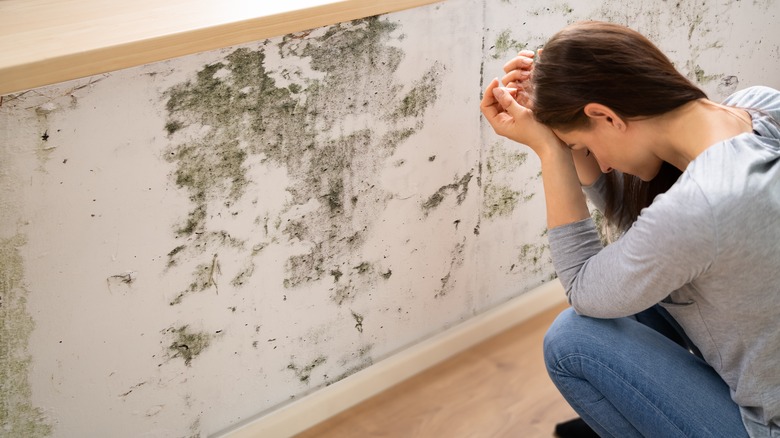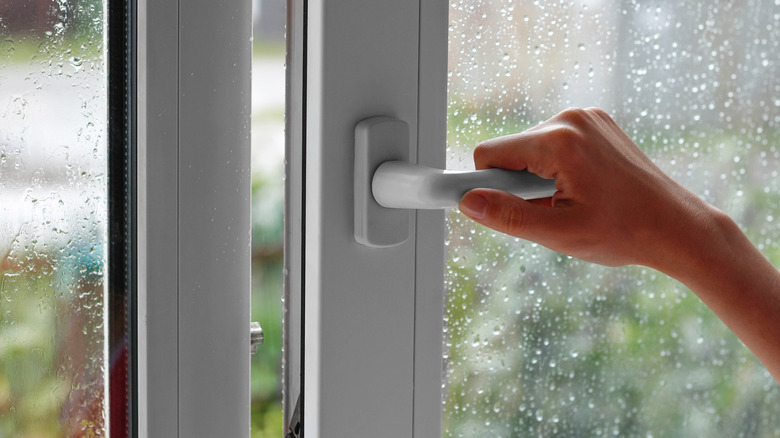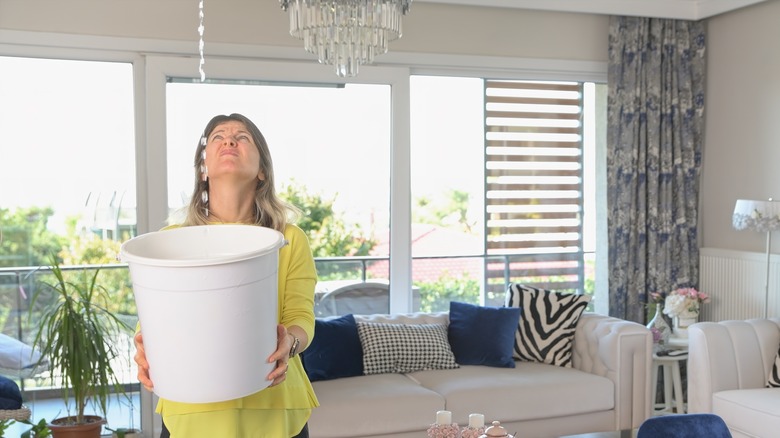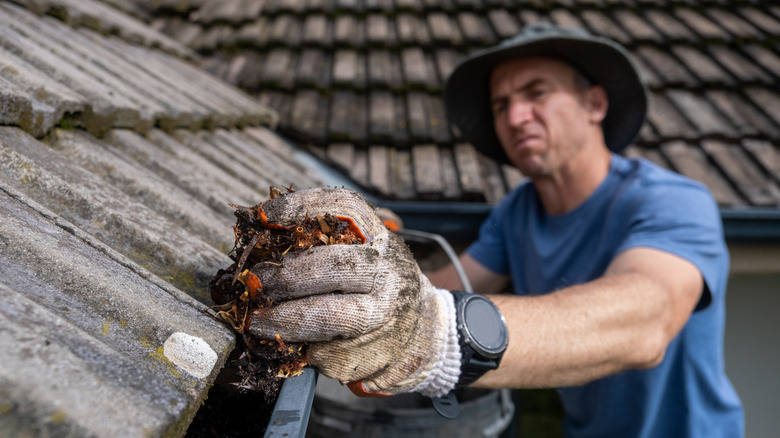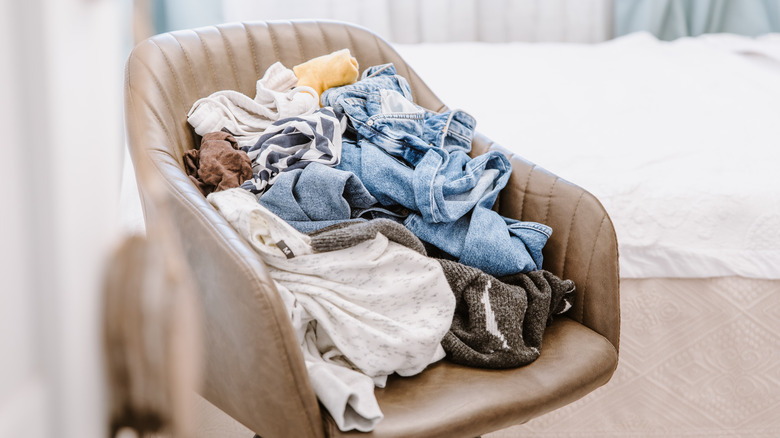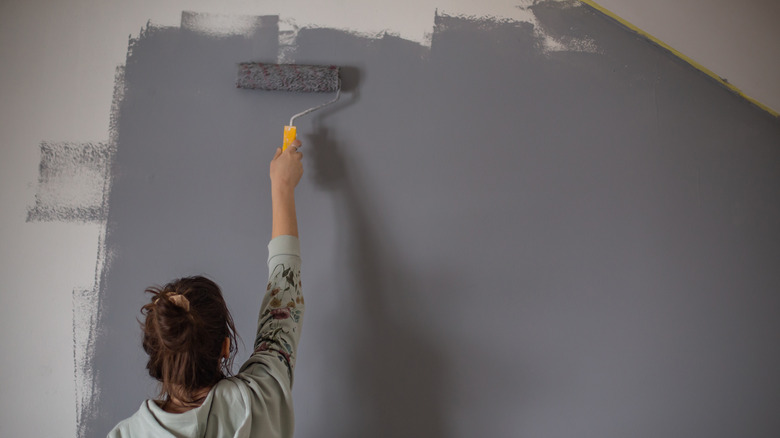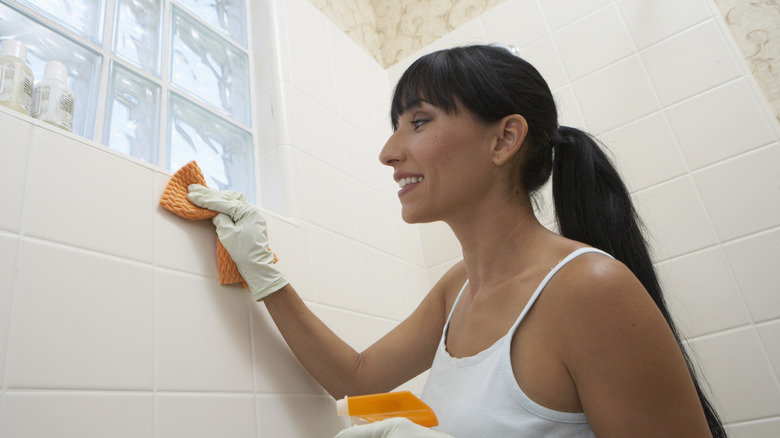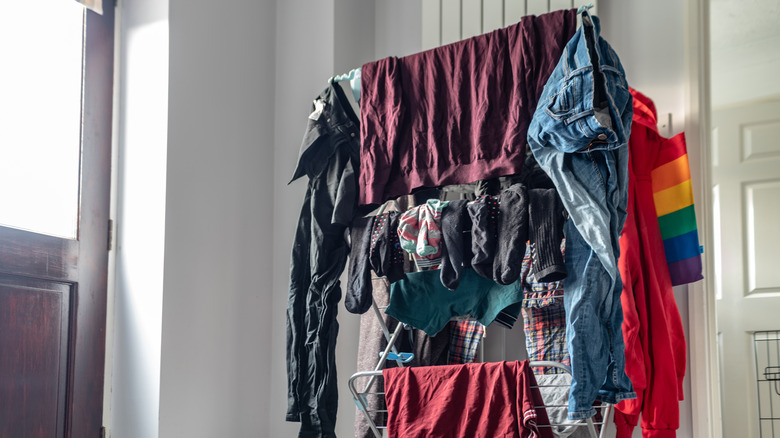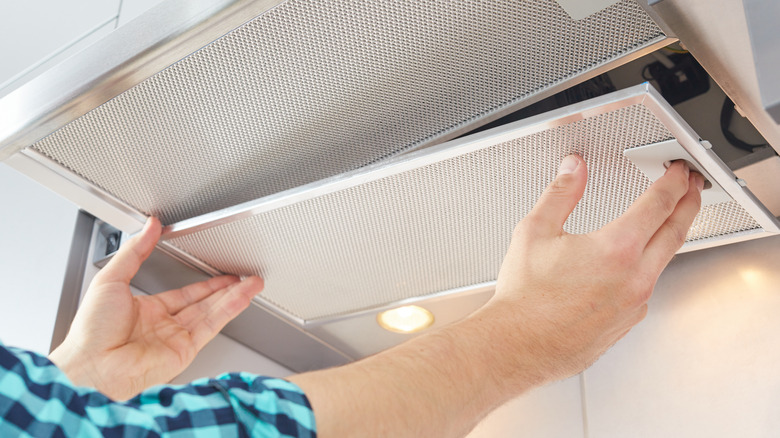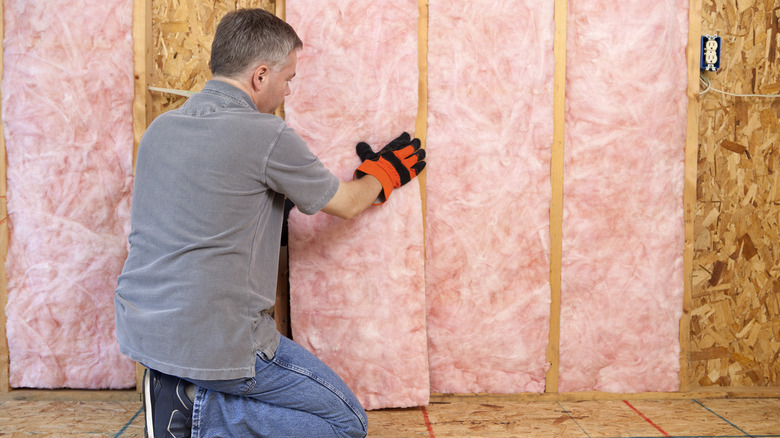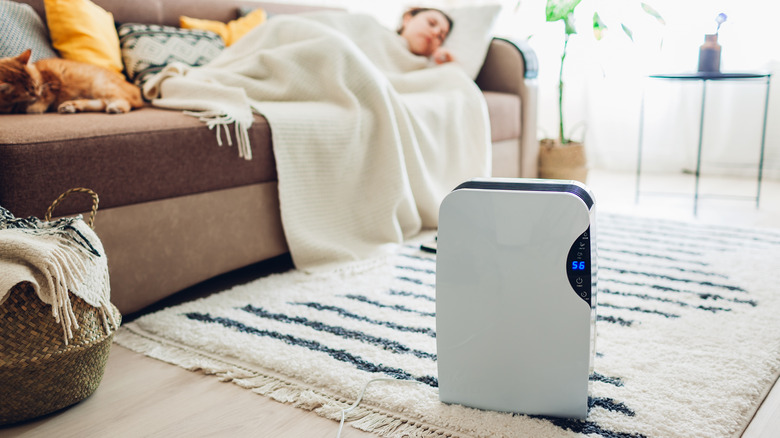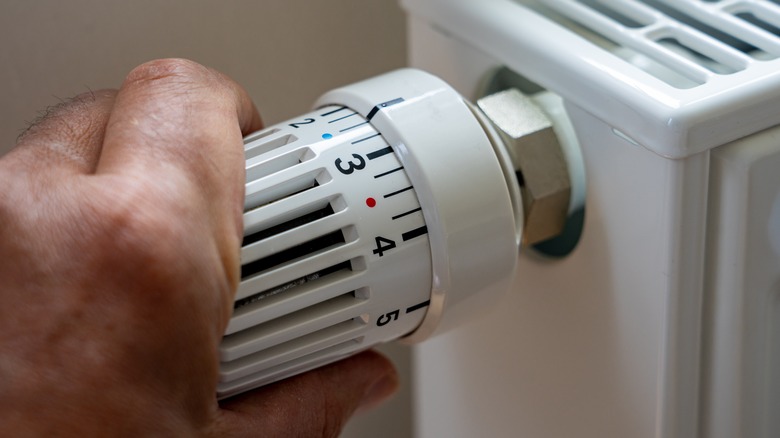Follow These Tips To Prevent Mold From Entering Your Home
We may receive a commission on purchases made from links.
If there's one uninvited guest guaranteed to strike fear into the hearts of homeowners everywhere, it's mold! It can grow undetected, and when you first spot it, the damage is often already done. Preventing mold from entering your home in the first place is the most effective way to deal with the nasty stuff. Thanks to Sir Alexander Flemming, mold may have revolutionized healthcare in the shape and form of penicillin. Yet what works well in a petri dish doesn't look so hot on your walls or ceilings.
Mold is insidious and sinister as it sounds. Its spores spread like wildfire and are extremely resilient. It is very adaptable and can grow anywhere there is moisture. It thrives in damp conditions and can cause untold physical and financial damage to your home. In severe cases, it can be extremely detrimental to your health, particularly for asthma or COPD sufferers. Once mold has infiltrated your home, it can still be dealt with. However, it's always better to do the simple things to make your home mold resistant before it gets to the point of no return. Mold is persistent and tenacious, and so must you be in defense of hearth and home. Here are some top tips to keep the enemy at bay.
Let your house breathe with adequate ventilation
Where there's moisture, you can bet your bottom-dollar mold will follow like an unwelcome intruder in its wake. To stop it in its tracks, ensure you ventilate your house properly. Moisture builds in the air when you boil water, run a bath, or spin the clothes tumbler. It's not something you can prevent unless you live in a cave with no electricity. However, you can ensure moisture doesn't get trapped in your home and give mold a free ride to shake its nasty thing all over the place.
The most tried and trusted technique to ventilate your house is to simply open the windows. The circulation of fresh air in your home allows it to breathe. As the moisture flows outside as opposed to setting up home on your walls and ceilings, it denies mold a foothold. It works particularly well after a steamy shower. Yet it's not a magic bullet, and opening windows won't cut it if it's raining outdoors or overwhelmingly humid. However, that's why we have fans and extractor units. These devices are particularly useful in bathrooms and bedrooms when it comes to sucking the moist air out of your humble abode. Keeping the doors of your rooms open will also allow air to circulate throughout the house. To ensure optimum air conditions, you could consider investing in a ventilation system for your home if you don't already have one.
Fix any leaks
Leaks are an unfortunate fact of life, but that doesn't make them any more palatable. The slow and incessant drip of water can have an erosive effect on your home and peace of mind. Depending on the size of the leak, the water damage can range from mild to monstrous. Yet after the missing roof tile is replaced or the flooded basement is cleared of water, the real threat rears its ugly head. Mold thrives on the dampness and high humidity levels caused by a leak that's been left unchecked. It may take time to show its face, but when it does, you'll know about it.
It's important to fix any leaks as soon as they are detected to prevent mold from getting a foothold. The water from a leak soaks into the porous materials of your home, and the humidity prevents it from evaporating, providing perfect conditions to cultivate mold. As soon as a leak is detected, turn off the water supply if it's an internal problem and call in the experts. Any water damage should be dried within a 48-hour timeframe to stop mold from setting in. Remove wet carpets and furniture if necessary.
Clean your gutters regularly
Gutters are an integral part of our home's water management system, but we're all a bit guilty of taking them for granted. When the storms blow and rains fall, they channel water effortlessly and effectively from our home's siding and foundations to the nearest drain. When leaves and other debris accumulate in your gutters and form a blockage, water can not drain away properly. When it sits in your gutters, it leads to dampness, which in turn can lead to mold and mildew forming on your walls, ceilings, and floors. Additionally, overflowing water could be leaking through widows or into your basement. You can avoid this by cleaning your gutters regularly.
Identifying a blockage in your gutter is a walk in the park. If water appears to be overflowing from them and streaming down the walls of your home when it's raining, then you have a problem. But don't worry; it's an easy fix. For two or three-story houses, it's best to call in the specialists. Attempting to scale the roof is not worth the risk. However, for a one-story home, you can use a sturdy extension ladder and clean away the debris by hand. If you have a fear of heights or are not comfortable using a ladder, you can use a common garden hose with a gutter-cleaning attachment. If the gutter is not clogged too thoroughly, this is a great way of blasting out all the dead leaves and twigs.
Stop clutter accumulating
We're all a little guilty of hoarding one too many possessions in the dark corners and forgotten places of our homes. Yet over time, those books, knick-knacks, and boxes full of memories gather dust, and if you're not careful, throw an open invite for mold to come and join the party. Clutter reduces airflow and collects moisture. When your items are stacked on top of one another in the back of the closet or shoved against a basement wall, it creates a dark and damp spot that mold loves with a passion.
In the worst-case scenario, clutter can block an air vent in the attic, basement, or crawl space and become a recipe for disaster. The solution is to de-clutter. Giving your unwanted and unused items to charity is good for the soul and will help stop mold in its tracks. De-cluttering will also help improve your home's feng shui and personal peace of mind.
Use special mold-inhibiting paint
Prevention is the best cure when it comes to tackling mold. Once it has infiltrated that sanctity of your home, it's a difficult beast to tame, let alone keep from the door indefinitely. If you've experienced a bad case of mold and dread it making a reappearance, or if you just want to ensure it never steps foot inside your house, mold-inhibiting paint could be the perfect solution.
It is different from regular paint in that it has a unique anti-microbial formula that prevents mold spores from growing upon it. Sure, it has superpowers, but mold is a cunning foe, and if there's the tiniest crack in the wall the paint hasn't covered, it will exploit it. So ensure you fully cover any surface if you use mold-inhibiting paint. The good news is it comes in as many shades and hues as regular paint. However, you cannot apply it to an existing mold patch and hope for the best. You need to remove all evidence of it before you begin. If used alongside other mold-busting techniques, such as adequate ventilation, mold-inhibiting paint can work wonders.
Blitz your bathroom with mold-busting products
A bathroom can almost serve as a promised land to mold spores. It's a kingdom of humidity, heat, and moisture where mold can easily fly under the radar. When those distinctive black spots brazenly show up, it's time to grab some mold-busting products and get blitzing. A great many mold infestations begin in the bathroom before they spread to other areas of your home. A small infestation on the wall, tiles, or ceilings of about 11 to 15 square inches can be eliminated using a bleach-based product or rubbing alcohol. Vinegar works if there is only a little mold on a smooth surface but is ineffective on fungal spores.
Baking powder is a reliable mold buster when mixed with a little water to create a paste. Apply the solution with an old toothbrush but be careful with sensitive surfaces because it might damage them. When tackling mold, it's always advisable to ventilate the area appropriately and wear gloves, safety glasses, and a protective mask. If mold has spread to bath mats, curtains, or towels, you need to dispose of them. To ensure your bathroom stays mold-free, keep the window open as often as possible, and always wipe down damp surfaces and corners after showering or bathing. To stop moisture from spreading elsewhere in your home, you should always keep the bathroom door shut.
Do not use carpets in bathrooms or basements
Carpets in bathrooms and basements may seem civilized and add a little creature comfort and glamor to purely functional areas, but they can be both unhygienic and attractive to mold. Bathrooms are high-moisture environments, and covering the floor in plush, absorbent material and padding is asking for trouble. There are a lot of spills and splashes in the bathroom. Whereas a small rug can be removed, a laminate, tiled, or hardwood floor can be dried, a carpet just sits there stewing in its own juices until the mold sets in.
Although you don't tend to enjoy a hot bath or relaxing shower in the basement, these underground rooms often contain a lot of trace moisture that can subtly seep into a carpet. Although it might be tempting to cover that cold, unsightly, and expansive sprawl of concrete floor with a luxurious shag to make your hobby cave more habitable, don't! If the moisture doesn't let mold in through the back door, a faulty water heater or an unexpected flood caused by heavy rainfall will ruin the carpet. Worse still, all that damp air will conspire to create perfect conditions for you know what! To keep your basement mold-free and healthy, it's always best to leave it uncarpeted.
Don't dry clothes indoors
When the sun shines and a strong southwesterly blows, you couldn't ask for better conditions for drying a floral frock or pair of pinstripes. However, when the snow falls and temperatures dip in the heart of winter, it doesn't make for optimum drying conditions. So what's a soul to do? A tumble dryer is an expensive and climate-unfriendly option that is off the menu for a lot of people. A clothes horse is often a more environmentally sound and cheaper choice. Or if push comes to shove, a radiator is just the ticket. However, here's the problem — drying wet clothes in the home is not recommended.
Having wet clothes hanging around the house or draped over radiators is a common cause of condensation and mold in the home. Managing Director at Homecure Plumbers, Lee Devlin, told Country Living, "The wet clothes expel moisture into the air as they dry, which, if not ventilated enough can condense on cold surfaces and eventually develop into build-ups of mold and mildew. Where possible, dry wet clothes outside or use a dryer. Not only do these help dry clothes quicker, but they also stop moisture from building up in the home." If you cannot hang clothes outside, dry them indoors next to ventilation spots and keep the windows open for a minimum of 15 minutes each morning. When it's cold outside, the chance of moisture building in your house overnight goes through the roof.
Clean your extractor fans regularly
Exhaust fans are a gift from god. They silently spin, precisely purr, and subtly extract your home's unwanted dust, moisture, and unpleasant odors. They work around the clock and ask for nothing in the way of payment or thanks. Yet you do need to clean them regularly if you want them to continue doing their job effectively and efficiently. Exhaust fans are not usually on top of everyone's cleaning lists, which is unfortunate because they cannot extract the full amount of moisture from a room when they become clogged. And as we know, mold soon comes knocking when moisture hangs around for any length of time.
Mold and mildew also have a habit of forming on their filters, vents, and blades when they remain uncleaned for any length of time. This has a knock-on effect of circulating mold spores, bacteria, and germs throughout your home. Ensure the exhaust is switched off at the mains before your begin. Take off the outer cover and wash it in some warm washing-up-liquid solution. Take a damp cloth and wipe over the fan blades. Never soak them, and ensure they are bone dry post-cleaning. Any filters in your fan should be washed and dried before replacing. When everything has been reinstalled correctly, you can turn them back on, and they can get on with the business of sucking the moisture from the air.
Make sure your home is properly insulated
If your home isn't properly insulated, you're running the risk of fighting a mold attack on all fronts. Insulation is one of the best weapons in your armory to prevent an outbreak. Properly installed insulation will encourage dry conditions and manage your home's temperature and moisture levels.
There are a range of insulation types to choose from. The trick is to select the right one for your environment. Cellulose insulation, for example, is a paper-based insulation that only works if it doesn't get wet. If water reaches it, then it can become an ideal place for mold to thrive. Fiberglass insulation is non-biodegradable, and its sharp surface will puncture mold spores before they can lay down roots. However, fiberglass backing is often made of paper which is a mold food source. Your best bet may be to use fiberglass insulation minus its backing. Insulating the attic is a different job from insulating a cavity wall, so always contact the professionals for a full inspection of your home before you carry out any insulation work.
Use a dehumidifier
When you control the humidity and excess moisture in your home, you can effectively control the mold. And what better way to help keep it in check than in the form of a dehumidifier? It's recommended that any humidity level below 50% in your home is ideal, and a reliable dehumidifier can help you reach that target. Mold's superpower is that it can suck the moisture clean from the air and use it to grow. A dehumidifier will remove the moisture before the mold gets a chance to feed.
Mechanical dehumidifiers, sometimes called refrigerative dehumidifiers because they often use the same cooling technology, work by absorbing the damp air and collecting it as water. Absorption dehumidifiers create dry air by pulling in moisture-heavy air and blowing it out the other end using a desiccant such as silica gel. Dehumidifiers work best when placed in areas of your home prone to excessive moisture. In conjunction with a dehumidifier, you might want to invest in an air purifier. Whereas dehumidifiers can disrupt the conditions mold needs to survive and thrive, air purifiers can remove mold spores from the environment, making it harder for them to get a foothold in the first place.
Turn on the heat!
Sometimes the simplest remedies are the most effective, and all you need to keep mold from darkening your door, particularly in the heart of winter, might be to turn on the heat! Dave Johnson, Head of Technical at The Underfloor Heating Store, told Wales Online, "We recommend always keeping your home temperature above [57] degrees in order to avoid your rooms cooling completely." This way, you stop condensation from forming on your windows, minimizing the risk of moisture. He also added, "When comfortable to do so, we recommend opening windows and other outlets for short periods of time in order to assist the ventilation process. Kitchen and bathrooms, typically, are at the greatest risk of mold infestation due to the high amount of steam and moisture produced in both."
Bathroom expert Evan Jones from Bathroom Supastore told The Sun that keeping your home's temperature at a certain level to prevent the build-up of moisture is more effective than any mold-busting hack. He explained, "Treating mold can be expensive so making sure the temperature in your home doesn't drop isn't as expensive in comparison."
